A terrifically torrefied, modern mahogany magnificence, the Martin D-222
is made in honor of the original Ditson Dreadnought
D-222 specs include: Standard 12-fret Dreadnought body size; all solid wood construction throughout, including traditional Big Leaf mahogany back and sides; Sitka spruce top with M2 level of Martin’s Vintage Tone System, scalloped 5/16″ bracing; grained ivoroid binding on body, soundhole, and neck; Modified V neck profile with 1-3/4″ width at nut, 2-1/4″ at 12th fret; ebony fingerboard and straight pyramid bridge with 2-1/4″ string spacing; bone saddle and nut; vintage Ditson appointments for the fret markers and rosette, tortoise colored pickguard; slotted headstock with Indian rosewood faceplate; StewMac Golden Age tuners.
“A suntanned siren with soft, round shoulders, broad across the top, with wide hips, and a husky yet sultry voice both pleasing and powerful…”
~
The Beauty with the Big Guns
The Martin D-222 is a 12-fret Dreadnought with appointments reminiscent of the 222, a model made by Martin for the Ditson company of music supply department stores. First traced out in 1916, and later named Dreadnought, it introduced to the world what become the most popular acoustic guitar body size in history.
But this is no throwback or time capsule recreation. Current versions of classic design elements are combined with advances in technology that have evolved from 1916 to the present day, to make the D-222 very much a modern Martin. It is exceptionally versatile in terms of contemporary music making, with dynamics, playability, and tone that are a joy to perform with.
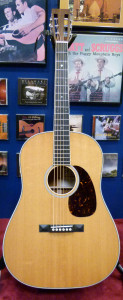 The bottom end is full and round with a fat throb. The midrange notes are meaty and strong, and as buoyant and projecting as the unwound trebles, which ring precise and pure, yet with a plump undertone behind them welling up out of the bottom end, succulent with warmth.
The bottom end is full and round with a fat throb. The midrange notes are meaty and strong, and as buoyant and projecting as the unwound trebles, which ring precise and pure, yet with a plump undertone behind them welling up out of the bottom end, succulent with warmth.
Like all well-made 12-fret dreads, when it comes to sound, the D-222 not only has a bigger bass than other acoustic guitars, it has a bigger everything. The balance across the strings is one of the reasons a 12-fret dreadnought is so impressive. In terms of voice and volume, it is an extra-large fingerstyle guitar that cannot be beat when it comes to power strumming or finesse flatpicking.
This is my favorite flavor of Martin mahogany tone – a large sound chamber with Sitka spruce on top to add some muscle to the clear and woody mahogany voice. But here the top has been treated by Martin’s propriety Vintage Tone System of wood torrefaction, which uses high heat in a low oxygen kiln to render the cellular interiors of the spruce more conducive to the transference of sound-producing energy. Making it similar to wood that has aged and been played-in for many, many years.
The darker coloring on the spruce shows it is the M2 level of the VTS, which means the physicality of the top is much like spruce that has aged for 200 or 300 years. And that translates to a wonderful sonic depth and an effortless resonance, so even the lightest playing is alive with character, while a more forceful attack reaps a richness and roar that never loses that clarity and ring mahogany lovers seek. And the natural VTS coloring of the spruce aesthetically fits the nut brown mahogany very well indeed.
A suntanned siren with soft, round shoulders, broad across the top, wide across the hips, and a husky yet sultry voice both pleasing and powerful, the D-222 is D-lightful to hug, D-lovely to play with, and D-liscious to hear singing a favorite tune.
Signs of Intelligent Designs
While the D-222 pays homage to those early dreadnought models, several key factors make it quite different from vintage Ditsons or even the modern interpretations Martin has offered in recent years.
In terms of basic guitar construction, the D-222 is similar to the D-18VS, the 12-fret mahogany and Sitka spruce dreadnought from the now defunct Vintage Series, and a personal favorite of mine, because it sounded terrific when fingerpicking, flatpicking, or strumming with a pick.
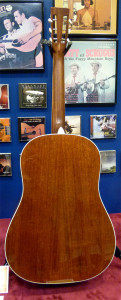 They have the same woods, genuine Big Leaf mahogany and Sitka spruce, in the same 12-fret dread body size, with the same contemporary construction and scalloped top bracing used on other excellent Martins like the HD-28 and D-45. And that adds up to a guitar that takes to rock star strumming and lead guitar playing like a duck to water, but still sounds pretty when picked in a nuanced or relaxed fashion.
They have the same woods, genuine Big Leaf mahogany and Sitka spruce, in the same 12-fret dread body size, with the same contemporary construction and scalloped top bracing used on other excellent Martins like the HD-28 and D-45. And that adds up to a guitar that takes to rock star strumming and lead guitar playing like a duck to water, but still sounds pretty when picked in a nuanced or relaxed fashion.
But where those other guitars did not respond as well as some reproductions of pre-war Martins with lighter construction, the VTS helps the D-222 sound with more vintage-like dynamics. It is amazingly open and expansive a voice for a brand new guitar.
What made the Vintage Series unique from the Standard Series Martins was the use of vintage-esque cosmetic trim and V necks that were modified in their girth and shape to make them easier to play than prewar Martins. The D-222 has the same 1-3/4″ Modified V neck as the D-18VS, rather than the wide 1-7/8″ neck of traditional Martin 12-fret dreadnoughts. But it also has upscale grained ivoroid binding, reflecting the original Ditson aesthetics.
It is the 2-1/4″ string spacing that sets the D-222 apart. It makes the neck feel sleeker than any other 12-fret dread I can recall, as it has the same combination of string spacing and neck shape as the Laurence Juber signature model OMs. Traditional 12-fret dreadnoughts have a wide 2-3/8″ string spacing, and the Vintage Series versions had 2-5/16″.
Martin could have made the D-222 as another Ditson repro with lighter than air construction and a big, wide neck. But the actual results are the product of the Martin Ditson legacy, in a guitar better suited for a wider range of contemporary musicians, who can make good and practical use of a modern 12-fret dread with a wide range of versatility.
Click on Photos to Enlarge
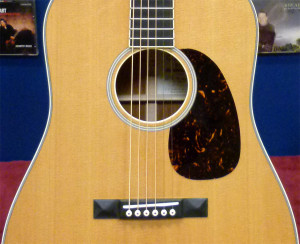 |
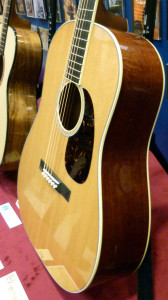 |
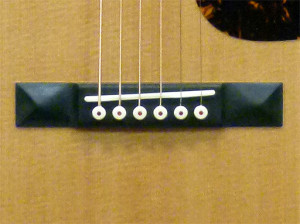 |
100 Years of Dread
One day, so the story goes, Mr. Ditson was at the Martin Guitar Factory to order new stock, when he espied an enormous guitar at the workbench of one 23 year-old John Henry Deichman. It was constructed as an experiment with no intention of going into actual production. Ditson wanted to offer it for sale as a “bass guitar” for members of the civic and amateur mandolin orchestras that were popular at the time. Martin agreed.
“Dreadnought” was originally a nickname used only inside Martin. The term came from the largest class of British battleship, ruling the waves at that time in world history. And like its navel counterpart, the new Ditson model was bigger and with a more powerful boom than anything Martin had made before.
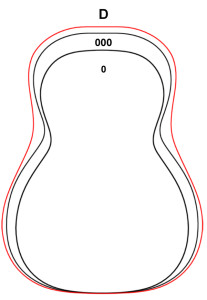 Although no one is now alive to confirm it, I remain convinced it started out as a double entendre. Martin’s largest guitar sizes were designated by the use of the zero, which was then commonly called the “naught” or the “aught.” At the Martin factory to this day, the 0, 00, and 000, are pronounced as “single aught,” “double aught,” and “triple aught.”
Although no one is now alive to confirm it, I remain convinced it started out as a double entendre. Martin’s largest guitar sizes were designated by the use of the zero, which was then commonly called the “naught” or the “aught.” At the Martin factory to this day, the 0, 00, and 000, are pronounced as “single aught,” “double aught,” and “triple aught.”
Originally spelled Dreadnaught, the new size, with its 12-fret neck, sloped shoulders, wide bottom bout, deep sides, and cavernous sound chamber, was the biggest aught of them all.
The Ditson Company was torpedoed by the Crash of 1929 and sank beneath the waves of the Great Depression. Martin was then free to launch the Dreadnought into the broader market, under their own banner for the first time, which they did in 1931. The 14-fret version with its squared shoulders, appeared in the 1934 Martin catalog as “Orchestra Model Size D.” Between Martin’s two related Dreadnought designs they have accounted for more flattop, steel string acoustic guitars across all brands around the word than any other shape, by a long shot.
The Ditson stores offered guitars made at the Martin factory in three levels of cosmetic trim, designated from 1, with the simplest trim, to 3 with the most ornate. The size of the guitar was represented by the repetition of the style number. So a 1 was the smallest size, the 11 was a size up, and the 111 was the largest size, which later became the Martin size D.
So, the 111 had the largest body in the simplest trim, the 333 was the largest and fanciest Ditson for sale, and the 222 had the same size but was in between the others in terms of trim and price. This Martin D-222 has the unshaded top of the Ditson 222, but actually has the bounded soundhole, fancier top purfling and diamond fingerboard markers of the top of the line 333.
This is somewhat ironic, since the official spec sheet lists the fret markers as Style 222. The actual Ditson 222 had the 3 graduated dots later seen on Martin’s first D-18s.
Dynamic Descendant
The Martin D-222 takes its inspiration from the Ur behemoth made in 1916, and draws on innovations added to it over the years. The original design had fan bracing, similar to a classical guitar. It wasn’t until 1924 that Martin’s X-bracing was put on that big, wide top, and the Dreadnought attained its full firepower.
I am very happy that this commemorative limited edition has such cool, vintage Ditson looks, including the special fret markers and bound soundhole, but has the construction and bracing of a modern Martin, including a Vintage Tone System top, and with a neck that retains some vintage vibe, while having a fully adjustable truss rod and is easier to play than other 12-fret Martin dreads. In fact, this is the only 12-fret Martin dread currently in production.
Exactly 100 are being made to commemorate this historic 100th anniversary of the Dreadnought. Each offers, in one impressive guitar, the cutting-edge craftsmanship and unmatched tradition that placed C. F. Martin & Co. at the pinnacle of American luthiery since 1833, and the tone that rings clear with why a Martin dreadnought remains the guitar to which all others are compared.
And that is one man’s word on…
The Martin D-222
List price $4,999.00
Call your Martin dealer to find out their best price!
More Photos HERE
Read more about the use of torrefied spruce tops in modern guitar making HERE.
Other Related Reading:
2016 Martin Guitars: An Overview
Martin Authentic Series Reviews
2015 Martin Guitar Reviews Recap
Official Spec Sheet
Model: D-222 100th Anniversary
Construction: Dovetail Neck Joint
Body Size: D-12 Fret
Top Material: Sitka Spruce with VTS
Top Detail: N/A
Rosette: Multi-Stripe
Bracing Pattern: X Brace
Brace Shape: Scalloped
Brace Material: Sitka Spruce
Brace Size: 5/16″
Back Material: Genuine Mahogany
Back Detail: N/A
Back Purfling/Strip: N/A
Side Material: Genuine Mahogany
Side Detail: N/A
Endpiece: Faux Tortoise
Endpiece Inlay: N/A
Binding: Grained Ivoroid
Top Inlay Material: Multi-Stripe
Side Inlay Material: N/A
Back Inlay Material: Multi-Stripe
Neck Material: Select Hardwood
Neck Shape: Modified V
Neck Taper: Standard Taper
Plek: Yes
Nut Material: Bone
Headstock Shape: Slotted with Square Taper and Diamond
Headplate Material: East Indian Rosewood
Headplate Detail: N/A
Headplate Logo Style: Stamped on Back of Headstock
Headplate Binding Material: N/A
Heelcap: Grained Ivoroid
Fingerboard Material: Ebony
Scale Length: 25.4″
Neck Joins Body At: 12th Fret
Number of Frets Total: 19
Fingerboard Width at Nut: 1 3/4”
Fingerboard Width at 12th Fret: 2 1/4”
Fingerboard Inlay Material: Abalone
Fingerboard Inlay Style: Style 222
Fingerboard Binding Material: Grained Ivoroid
Side Dots: Faux Tortoise
Back and Side Finish: Gloss
Back and Sides Color: Dark Mahogany
Finish Top: Gloss
Top Color: Clear
Finish Neck: Satin
Neck Color: Dark Mahogany
Bridge Material: Ebony
Bridge Style: Pyramid – Drop in Saddle
Bridge String Spacing: 2 1/4”
Saddle: Compensated Bone
Saddle Radius: 16″
Tuning Machines: Golden Age Bright Nickel Side Mount
Recommended Strings: SP Lifespan 92/8 Phosphor Bronze Medium (MSP7200)
Knob: Ivoroid
Bridge Pin Material: White Plastic
Bridge Pin Dots: Faux Tortoise
Pickguard: Faux Tortoise
Pickguard Inlay: N/A
Case: Ply Hardshell
Label: Signed by CFM IV
Electronics: Optional
Left Handed Availability: Yes
~
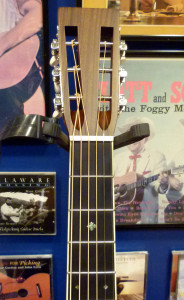
I have been a player and enthusiast for high quality mandolins and acoustic guitars for over 50 years. I’ve owned/played/traded everything but never really had a guitar which sounds as good as the Martin D222 I bought a few weeks ago. It has everything a professional would want. I bought it because I’ve always liked 12 fret join, slotted headstock, mahogany back and sides, bound all round including neck . I also like 1 and 3/4 nut and dislike the wider ones so this guitar was for me. The volume and tone are unsurpassed. Just fantastic.
Only two negatives:: 1. Playing at home sitting down is not the most comfortable. 2. I’d have preferred the Martin name on the headstock. I’m looking for a simple, removeable, transfer/sticker.
This guitar is just unbelievably good. The clarity is beautiful.
Great review and demo! Amazing guitar. I am lucky to have one.